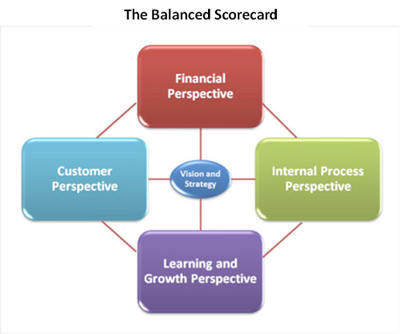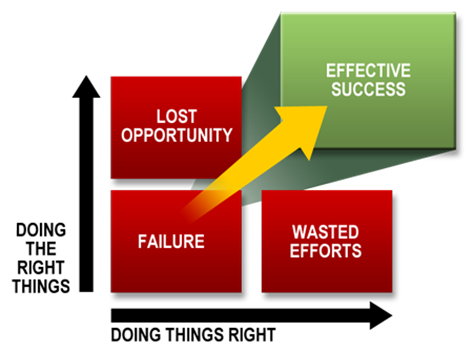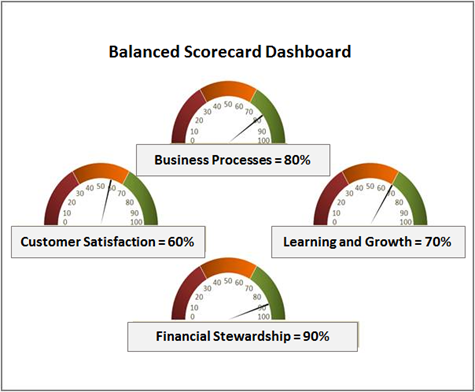“People and their managers are working so hard to be sure things are done right, that they hardly have time to decide if they are doing the right things.” – Stephen Covey
If you’ve ever tried to keep scorecards for a high school baseball team, which I did for a couple of years a long time ago, you learn after a while to keep track of what’s really important, ignoring the occasional slip while making sure the captured data points can be used to improve the team’s overall performance. Since then I’ve learned that well-managed enterprises, including some in government, use a similar approach.

The concept of managing by “balanced scorecard” has been around since the 1990s . When developed as a component of strategic planning and management methods and practices, Balanced Scorecards can help align an organization behind a commonly shared view of success, and get people working on the right things and focusing on results. In a large organization, a scorecard is more than a way of keeping score, it is a methodology that relies on the integration of people, strategy, processes, and technology. It enhances enterprise performance by deliberately applying a combination of goals, metrics, and process improvements.
Balanced Scorecard Defined
The Balanced Scorecard is a strategic planning and management methodology used extensively in business and industry, government, and nonprofit organizations all around the world to align business activities to the vision and strategy of the enterprise, improve internal and external communications, and account for organizational performance against strategic goals. This management methodology attempts to measure, analyze, and provide feedback to organizations to assist in implementing strategies and objectives. By taking a holistic approach, the Balanced Scorecard method also lets managers have insight into what enterprise-wide objectives have been met, and what is needed to achieve strategic goals. Managers waste less time monitoring and have an increased understanding of the steps needed to achieve their goals. Data collection is crucial to providing quantitative results, which are interpreted by managers and executives and used to make better long-term decisions.
The Balanced Scorecard business approach is designed to serve as the fusion center for enterprise strategy. Organizational vision and strategy guide the use of a balanced scorecard, while the financial, customer, internal process and innovation and learning perspectives are the primary factors that propel the enterprise in the planned direction. The Balanced Scorecard approach involves collecting data and analyzing the enterprise from those four separate perspectives. Learning and growth includes training and knowledge resources. Business processes reflect how well products and services meet customer needs. Customer perspectives indicate customer satisfaction levels. The financial perspective involves tracking financial data about enterprise performance, such as operating revenue and expenditure.
Balanced Scorecard Benefits
Many organizations find it hard to establish mechanisms that translate strategic vision into actionable goals and actions that can be managed well enough to provide credible evidence of progress in meeting the goals required to achieve the vision. To best leverage their available information repositories, leaders and managers must abandon the belief that traditional business intelligence offers sufficient analytical results. To better inform decision making, they must expand their analytical scope to include business performance management capabilities.
The Balanced Scorecard supports strategic planning and implementation by uniting the actions of all parts of an organization around a common understanding of its goals, and by facilitating the assessment and enhancement of strategy. Four questions should drive the actualization of strategic management goals: What strategic outcomes are important for the organization to achieve? What activities are needed to achieve them? Are these activities being done? Are we achieving the desired results?
Use of the Balanced Scorecard helps managers agree on, and then articulate, the strategic destination and transformation roadmap for their organization, and enables continuous monitoring of the activities required for their achievement. Over time, the benefits of the Balanced Scorecard approach then shifts from tracking performance of individual initiatives, to monitoring whether or not appropriate objectives have been set, and the extent to which the planned activities are working to achieve them. Eventually, managers get to the point of using the Balanced Scorecard to support decision making about interventions needed to ensure that the organization’s strategic goals can be fully achieved. When fully implemented, the Balanced Scorecard transforms strategic planning from what sometimes appears to be an academic exercise to a full set of related activities that form the nerve center of enterprise operations.
Doing the Right Things Right
A planning and management scorecard approach consumes strategic and operational performance information to measure and evaluate how well the organization is performing with financial and customer results, operational efficiency, and organization capacity building. As a robust strategic planning, management and communications methodology, the strategy-based Balanced Scorecard enables the alignment of work people do with vision and strategy, and the communication of strategic intent throughout the organization – and to external stakeholders. It also provides a basis for better alignment of strategic objectives with available resources. Using the Balanced Scorecard approach, strategic and operational performance measures are key reference data points, and those metrics can be used to better inform decision making at all levels of the organization. With such a strategy-based approach, accomplishments and results are the main focus.

Doing the right things and doing things right proves to be a balancing act that largely depends upon the development of sound business strategies (doing the right things) and efficient processes and operations to deliver the programs, initiatives, and services (doing things right) needed to enable achievement of the organization’s core mission.
Developing a balanced scorecard for an enterprise is a bit like putting a jigsaw puzzle together, however, where multiple and different pieces are arranged in patterns that yield a complete tableau. With the balanced scorecard, the pieces represent critical components that are built individually, then checked for alignment with other strategic components, and then assembled to complete a holistic performance accountability structure.
According to Kaplan and Norton’s approach the balanced scorecard should be designed to allow leaders to view an organization from four perspectives, while developing metrics and analyzing data collected to substantiate each of the following perspectives:
- The Learning & Growth Perspective — This perspective includes employee training and development, and cultural attitudes around individual and corporate self-improvement. In a knowledge-worker enterprise, people represent are the primary source of knowledge. Given the current environment of rapid changes in technology, it is increasingly essential for knowledge workers to adopt a continuous learning career development approach. Metrics can be established to inform management decisions about the allocation of training resources to investments that lead to better outcomes. It is important to understand that ‘learning’ is more than ‘training’. Employee development programs should include mentoring and coaching programs, accompanied by “good” communications media that allow workers to gain ready access to help as it is needed. It should also include what the Baldrige criteria call “high performance work systems” – i.e., the adequate provisioning of tools and technologies that help employees use their knowledge more effectively.
- The Business Process Perspective — This perspective refers to internal business processes, both customer facing process and what is often called “back-office” processes – those that touch employees directly (but not customers, usually). Metrics established to support this perspective enable managers to understand how well each of their business unit is performing, and whether its activities and services are actually contributing to mission outcomes – to the extent expected. These metrics must be designed by those who know their internal processes best.
- The Customer Perspective – Leaders of organizations everywhere, public and private, have been driven to a heightened appreciation of the importance of customer focus and customer satisfaction. They now fully understand that, if customers are not satisfied, they will soon find other product suppliers or service providers to meet their needs. In developing metrics for gauging customer satisfaction, information and data should be collected and analyzed to help determine who your customers are, what makes them happy, and how happy are they, at different points in time. The resulting indicator will enable leaders and managers to better understand their customers’ needs, wants, and nice-to-haves – in other words, vital insight into what keeps them coming back information (or not).
- The Financial Perspective – Government agencies do not always share the same bottom-line incentives to avoid operational inefficiencies (as industry). Yet, sound financial stewardship is a duty of all government leaders. And, as budgets become increasingly constrained, the management of funding data will become increasingly more critical to zero-sum decision-makers, leaving managers to do whatever is necessary to obtain and supply it. With the implementation of more “corporate” data repositories, more of the processing can be centralized and automated – which gives rise to a need to include more financial-related data, such as risk assessment and cost-benefit data, in this perspective.

The framework for the Balanced Scorecard Dashboard is built when measures and metrics are delineated for selected strategies, pursued to optimize each of the four perspectives outlined above.
Mapping to Strategy
Strategy mapping is essential to tell a story of how value is created for the enterprise, by mapping the metrics gathered, weighted, and aggregated (in support of the four perspectives of the balanced scorecard) to the organization’s overall strategies for achieving its mission. Strategy maps reveal a logical, step-by-step linkage between (and among) strategic objectives, in the form of a cause-and-effect relationship chain. For example, performance improvement in the objectives associated with the Learning & Growth perspective – however they get defined and instantiated — enables the organization to improve its Business Processes perspective, which in turn enables the realization of better results in both the Customer and Financial perspectives – which completes a full cycle of interlocking enterprise “wellness” (or “wholesomeness”).
The Bottom Line
Every government agency, no matter how big or small, needs a dashboard to give them a sense of direction, a gauge that lets employees, customers, and other stakeholders know where it’s headed and how it’s doing. The dashboard must be driven by the organization’s mission, vision, goals and objectives (and the strategies devised to meet or exceed them). When designed and implemented effectively, the dashboard soon becomes a tool that can be relied upon by managers to identify successful and non-productive operational trends and/or gaps in available resources or business processes. Once data is correctly collected and displayed, individuals must be assigned to manage and monitor each of the key performance indicators so that needed corrective actions can be quickly effected. The aim is to make sure that managers are not overloaded with too much information, and that refreshed data is delivered in timely successions to ensure that no one will be misled or blinded by missing data inputs. The use of performance dashboards for display and analysis of key performance indicators (KPIs) enables situational awareness of the health of each business unit, at any point in time, so that actions can be taken quickly, to improve efficiency and gain new insight into business processes that contribute to the success (or failings) of the entire enterprise.
The Balanced Scorecard was originated by Robert Kaplan (Harvard Business School) and David Norton as a performance measurement framework that added strategic non-financial performance measures to traditional financial metrics to give managers and executives a more ‘balanced’ view of organizational performance. While the phrase balanced scorecard was coined in the early 1990s, the roots of the this type of approach are deep, and include the pioneering work of General Electric on performance measurement reporting in the 1950’s and the work of French process engineers (who created the Tableau de Bord – literally, a “dashboard” of performance measures) in the early part of the 20th century.

















